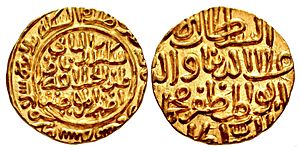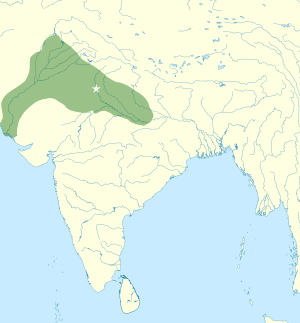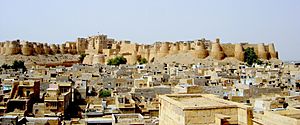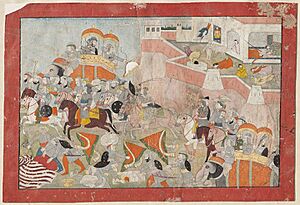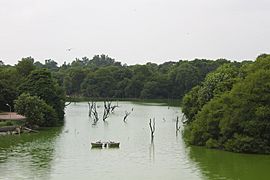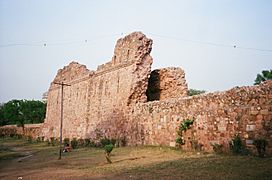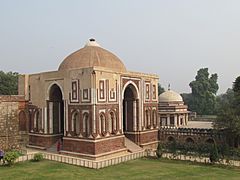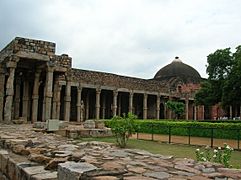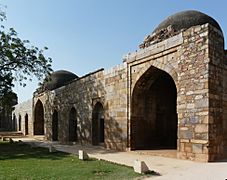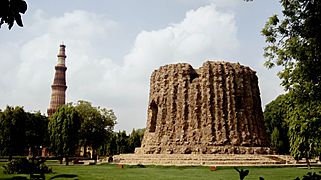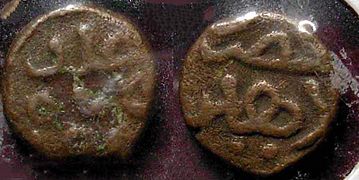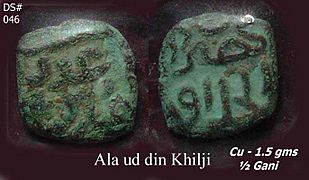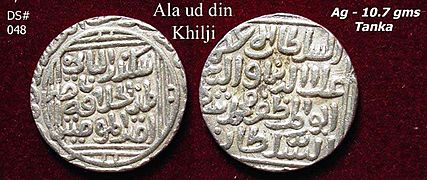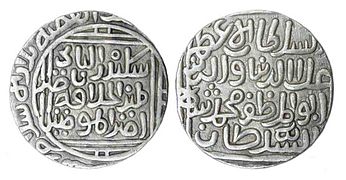Alauddin Khalji facts for kids
Quick facts for kids Alauddin Khaljiعلاءالدین خِلجی |
|||||
|---|---|---|---|---|---|
| Sultan Sikander-e-Sani (Alexander the Second) |
|||||
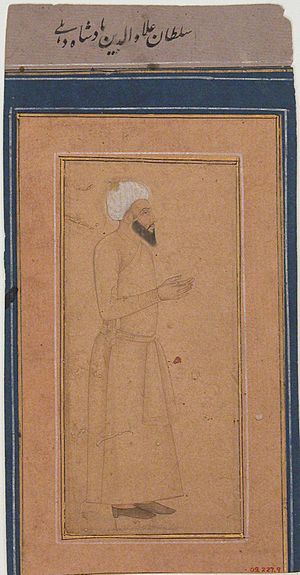
A 17th century portrait of Alauddin Khalji
|
|||||
| 13th Sultan of Delhi | |||||
| Reign | 19 July 1296–4 January 1316 | ||||
| Coronation | 21 October 1296 | ||||
| Predecessor | Jalaluddin Firuz Khalji | ||||
| Successor | Shihabuddin Omar | ||||
| Governor of Awadh | |||||
| Tenure | c. 1296–19 July 1296 | ||||
| Governor of Kara | |||||
| Tenure | c. 1266–1316 | ||||
| Predecessor | Malik Chajju | ||||
| Successor | ʿAlāʾ ul-Mulk | ||||
| Amir-i-Tuzuk (equivalent to Master of ceremonies) | |||||
| Tenure | c. 1290–1291 | ||||
| Born | Ali Gurshasp c. 1266 |
||||
| Died | 4 January 1316 (aged 49–50) Delhi (present-day India) |
||||
| Burial | Madrasa and tomb of Alauddin Khalji, Delhi | ||||
| Spouse |
|
||||
| Issue |
|
||||
|
|||||
| House | Khalji dynasty | ||||
| Father | Shihabuddin Mas'ud (brother of Jalaluddin Khalji) | ||||
| Religion | Sunni Islam | ||||
Alauddin Khalji (ruled 1296–1316), also known as Ali Gurshasp, was a powerful ruler of the Khalji dynasty. This dynasty governed the Delhi Sultanate in the Indian subcontinent. Alauddin made many important changes to how the government worked. These changes included new rules for collecting taxes, controlling prices, and managing society. He also successfully defended India from several Mongol invasions.
Alauddin was the nephew and son-in-law of the previous Sultan, Jalaluddin Khalji. When Jalaluddin became Sultan, Alauddin was given the role of Amir-i-Tuzuk, which was like a master of ceremonies. After helping to stop a rebellion against Jalaluddin, Alauddin became the governor of Kara in 1291. He also became governor of Awadh in 1296 after a successful raid on Bhilsa. In 1296, Alauddin raided Devagiri and gathered a lot of treasure. He used this wealth to start a successful revolt against Jalaluddin. After Jalaluddin's death, Alauddin took control of Delhi. He also brought Jalaluddin's sons under his rule in Multan.
Over the next few years, Alauddin successfully fought off Mongol invasions. These attacks came from the Chagatai Khanate. Major battles took place at Jaran-Manjur (1297–1298), Sivistan (1298), Kili (1299), Delhi (1303), and Amroha (1305). In 1306, his army won a big victory against the Mongols near the Ravi river. Later, his forces raided Mongol lands in what is now Afghanistan. Key military leaders who helped him defeat the Mongols included Zafar Khan, Ulugh Khan, and his slave-general Malik Kafur.
Alauddin conquered many kingdoms. These included Gujarat (raided in 1299, fully taken in 1304), Jaisalmer (1299), Ranthambore (1301), Chittor (1303), Malwa (1305), Siwana (1308), and Jalore (1311). These victories ended the rule of several Rajput and other Hindu dynasties. His general Malik Kafur led campaigns south of the Vindhyas mountains. He gained much wealth from Devagiri (1308), Warangal (1310), and Dwarasamudra (1311). These wins made the Yadava king Ramachandra, the Kakatiya king Prataparudra, and the Hoysala king Ballala III pay tribute to Alauddin. Kafur also raided the Pandya kingdom (1311), collecting many treasures, elephants, and horses.
Towards the end of his life, Alauddin became ill. He relied on Malik Kafur to manage the government. After Alauddin's death in 1316, Malik Kafur made Shihabuddin, Alauddin's young son, the new ruler. However, Alauddin's older son Qutbuddin Mubarak Shah soon took power.
Contents
Early Life and Rise to Power
Historians don't know much about Alauddin's early childhood. Some records suggest he was born around 1266–1267. His birth name was Ali Gurshasp. He was the oldest son of Shihabuddin Mas'ud. Shihabuddin was the older brother of Sultan Jalaluddin Khalji, who founded the Khalji dynasty. Alauddin had three younger brothers.
Jalaluddin raised Alauddin after his father's death. Both Alauddin and his younger brother Almas Beg married Jalaluddin's daughters. When Jalaluddin became Sultan, Alauddin was given the important role of Amir-i-Tuzuk.
Marriage and Early Challenges
Alauddin married Jalaluddin's daughter, Malika-i-Jahan, before 1290. Their marriage was not happy. Malika-i-Jahan became very proud after her father became Sultan and tried to control Alauddin. Alauddin later married a second woman named Mahru. This made Malika-i-Jahan very angry.
Alauddin also had problems with his mother-in-law, who had a lot of influence over the Sultan. She watched Alauddin closely. She also encouraged her daughter's proud behavior towards him.
Becoming Governor of Kara
In 1291, Alauddin helped put down a rebellion by Malik Chajju, the governor of Kara. Because of this, Jalaluddin made Alauddin the new governor of Kara. Some former officials in Kara thought Jalaluddin was a weak ruler. They encouraged Alauddin to take over the throne of Delhi. This, along with his unhappy home life, made Alauddin decide to overthrow Jalaluddin.
Planning to Take the Throne
Malik Chajju's supporters told Alauddin he needed a lot of money. He needed it to build a large army for a successful takeover. Malik Chajju's own rebellion had failed because he lacked resources. To get the money, Alauddin decided to raid nearby Hindu kingdoms.
In 1293, he raided Bhilsa, a rich town in the Paramara kingdom of Malwa. This kingdom was already weak from many invasions. In Bhilsa, he learned about the huge wealth of the southern Yadava kingdom in the Deccan. He also found out about the routes to their capital, Devagiri. Alauddin cleverly gave the loot from Bhilsa to Jalaluddin. This helped him gain the Sultan's trust. He kept quiet about the Yadava kingdom's wealth.
A pleased Jalaluddin made him the Minister of War. He also made him the governor of Awadh. The Sultan also let Alauddin use extra tax money to hire more soldiers.
After years of planning, Alauddin successfully raided Devagiri in 1296. He returned with a huge amount of wealth. This included precious metals, jewels, silk, elephants, horses, and slaves. When Jalaluddin heard of Alauddin's success, he went to Gwalior. He hoped Alauddin would bring the loot to him there. However, Alauddin marched straight to Kara with all the wealth.
Jalaluddin's advisors suggested stopping Alauddin. But Jalaluddin trusted his nephew. He went back to Delhi, believing Alauddin would bring the wealth to him later. At Kara, Alauddin sent an apology letter to the Sultan. He said he was worried his enemies had turned the Sultan against him. He asked for a letter of pardon from the Sultan. The Sultan immediately sent it.
Jalaluddin's messengers at Kara learned of Alauddin's strong army. They also found out about his plan to take the throne. But Alauddin held them back. He stopped them from telling the Sultan.
Meanwhile, Alauddin's younger brother, Almas Beg (later Ulugh Khan), was married to Jalaluddin's daughter. He assured the Sultan that Alauddin was loyal. He convinced Jalaluddin to visit Kara in person. He said Alauddin would feel guilty if the Sultan didn't forgive him face-to-face. Jalaluddin, trusting his nephew, set out for Kara with his army.
Near Kara, he sent his main army by land. He himself crossed the Ganges river with about 1,000 soldiers. On July 20, 1296, Alauddin had Jalaluddin killed. He did this after pretending to greet the Sultan. He then declared himself the new king. Jalaluddin's companions were also killed. The main army retreated to Delhi.
Becoming Sultan
Alauddin, whose birth name was Ali Gurshasp, was officially declared the new king in July 1296. He took the title Alauddunya wad Din Muhammad Shah-us Sultan at Kara. Jalaluddin's head was paraded on a spear before being sent to Awadh. For the next two days, Alauddin set up a temporary government in Kara. He promoted existing officials and appointed his friends to new positions.
It was a time of heavy rains, and the Ganga and Yamuna rivers were flooded. But Alauddin prepared to march to Delhi. He told his officers to recruit as many soldiers as possible. He wanted to show that he had huge public support. To appear generous, he had gold coins shot from a catapult into a crowd in Kara.
One part of his army, led by him and Nusrat Khan, marched to Delhi through Badaun and Baran. Another part, led by Zafar Khan, marched through Koil. As Alauddin marched, news spread that he was hiring soldiers and giving out gold. Many people, both military and non-military, joined him. By the time he reached Badaun, he had a huge army.
At Baran, seven powerful nobles who had served Jalaluddin joined Alauddin. Alauddin gave each of them a lot of gold. He also gave their soldiers silver coins.
Alauddin's march to Delhi was stopped by the flooded Yamuna river. In Delhi, Jalaluddin's widow, Malka-i-Jahan, made her youngest son, Qadr Khan, the new king. She did this without asking the nobles. This angered Arkali Khan, her older son and the governor of Multan. When Malika-i-Jahan heard that Jalaluddin's nobles had joined Alauddin, she apologized to Arkali. She offered him the throne and asked him to march from Multan to Delhi. However, Arkali refused to help her.
Alauddin continued his march to Delhi in October 1296, after the Yamuna river went down. When he reached Siri, Ruknuddin led an army against him. But some of Ruknuddin's army switched sides to Alauddin during the night. A discouraged Ruknuddin then fled to Multan with his mother and loyal nobles. Alauddin then entered the city. Many nobles and officials accepted his rule. On October 21, 1296, Alauddin was officially declared the Sultan in Delhi.
Strengthening His Rule
Alauddin first strengthened his power by giving out many gifts and government jobs. He made sure power was balanced among officials from different past rulers. He also made the Sultanate's army stronger. He gave every soldier a year and a half's salary in cash. The historian Ziauddin Barani wrote that Alauddin's first year as Sultan was the happiest Delhi had ever seen.
At first, Alauddin didn't control all the lands that used to belong to Jalaluddin. In the Punjab region, his power was only east of the Ravi river. Areas beyond Lahore faced Mongol raids and Khokhar rebellions. Multan was controlled by Jalaluddin's son Arkali, who protected those who had fled from Delhi. In November 1296, Alauddin sent an army led by Ulugh Khan and Zafar Khan to conquer Multan. On his orders, Nusrat Khan arrested, blinded, or killed the remaining members of Jalaluddin's family.
Soon after conquering Multan, Alauddin made Nusrat Khan his wazir (prime minister). After securing Delhi, the Sultan began removing officials he hadn't appointed himself. In 1297, the nobles who had left Jalaluddin's family to join Alauddin were arrested, blinded, or killed. All their property, including the money Alauddin had given them, was taken away. Nusrat Khan gained a huge amount of money for the royal treasury from these seizures. Only three nobles from Jalaluddin's time were spared. The rest of the older nobles were replaced with new ones who were very loyal to Alauddin.
Meanwhile, Ala-ul Mulk, Alauddin's governor at Kara, came to Delhi. He brought all the officers, elephants, and wealth Alauddin had left at Kara. Alauddin made Ala-ul Mulk the kotwal (chief police officer) of Delhi. He put all non-Turkic city workers under his command. Since Ala-ul Mulk had become very heavy, the governorship of Kara was given to Nusrat Khan. Nusrat Khan had become unpopular in Delhi because of the property seizures.
Military Campaigns
Fighting the Mongols and Northern Conquests (1297–1306)
In the winter of 1297, Mongols led by a general from the Chagatai Khanate raided Punjab. They advanced as far as Kasur. Alauddin's forces, led by Ulugh Khan, defeated the Mongols on February 6, 1298. Many Mongols were killed in the battle. More were killed in Delhi after being taken prisoner. In 1298–99, another Mongol army invaded Sindh. They took the fort of Sivistan. This time, Alauddin's general Zafar Khan defeated the invaders and took back the fort.
In early 1299, Alauddin sent Ulugh Khan and Nusrat Khan to invade Gujarat. The Vaghela king Karna offered little resistance. Alauddin's army looted several towns, including Somnath. They also took many people captive, including the Vaghela queen Kamala Devi and a slave named Malik Kafur. Kafur later became a key general in Alauddin's southern campaigns. On the way back to Delhi, some Mongol soldiers in the army started a mutiny. This happened after the generals tried to take a share of their loot. Alauddin's government punished the mutineers' families in Delhi very harshly.
In 1299, the Chagatai ruler Duwa sent a Mongol force to conquer Delhi. In the Battle of Kili, Alauddin personally led the Delhi forces. His general Zafar Khan attacked the Mongols without waiting for orders. Zafar Khan caused heavy losses to the invaders. However, he and other soldiers in his unit were killed. Qutlugh Khwaja, the Mongol leader, was also badly wounded. This forced the Mongols to retreat.
Conquering Northern India
Around this time, Alauddin focused on the Rajasthan area. He wanted to control the Rajput kingdoms. This would give him a secure base for future trips to Gujarat and Malwa, and for expeditions further south. In 1299 CE, Alauddin attacked the fortress of Jaisalmer. It was ruled by the Bhatis under Jait Singh I. After a long siege, the Rajputs ran out of food. The men fought until they died. Alauddin successfully took over the Bhattis' lands. Jaisalmer remained under Khalji rule for several years.
In 1301, Alauddin ordered Ulugh Khan and Nusrat Khan to invade Ranthambore. Its king, Hammiradeva, had given shelter to the leaders of the mutiny near Jalore. Nusrat Khan was killed during the siege. Alauddin then took charge of the siege himself. He conquered the fort in July 1301. During the Ranthambore campaign, Alauddin faced three failed rebellions. To stop future revolts, he set up a spy system. He also banned alcohol in Delhi. He made laws to stop his nobles from forming groups. He also took wealth from the general public.

In the winter of 1302–1303, Alauddin sent an army to raid the Kakatiya capital, Warangal. At the same time, he led another army to conquer Chittor. This was the capital of the Guhila kingdom, ruled by Ratnasimha. Alauddin captured Chittor after an eight-month siege. His courtier Amir Khusrau wrote that Alauddin ordered a large number of local Hindus to be killed after this victory. Some later stories say Alauddin invaded Chittor to capture Ratnasimha's beautiful queen Padmini. However, most modern historians do not believe these stories are true.
While the armies were busy in Chittor and Warangal, the Mongols launched another invasion of Delhi around August 1303. Alauddin reached Delhi before the invaders. But he didn't have much time to prepare a strong defense. The Warangal campaign had failed, and the army had lost many men and supplies. Neither this army nor reinforcements from Alauddin's governors could enter the city. The Mongols had set up blockades. In these tough times, Alauddin took shelter in a heavily guarded camp at the Siri Fort, which was still being built. The Mongols fought some small battles with his forces. But neither side won a clear victory. The invaders looted Delhi and its surrounding areas. But they eventually left after failing to break into Siri. The Mongol invasion of 1303 was one of the most serious for India. It made Alauddin take many steps to prevent it from happening again. He strengthened forts and military presence along the Mongol routes. He also made economic changes to ensure enough money for a strong army.
In 1304, Alauddin likely ordered a second invasion of Gujarat. This led to the Vaghela kingdom becoming part of the Delhi Sultanate. In 1305, he launched an invasion of Malwa in central India. This resulted in the defeat and death of the Paramara king Mahalakadeva. The Yajvapala dynasty, which ruled northeast of Malwa, also seems to have fallen to Alauddin's invasion.
In December 1305, the Mongols invaded India again. Instead of attacking Delhi, they went southeast to the Gangetic plains. Alauddin's 30,000-strong cavalry, led by Malik Nayak, defeated the Mongols at the Battle of Amroha. Many Mongols were captured and killed. Some historians claim that the heads of 8,000 Mongols were used to build the Siri Fort.
In 1306, another Mongol army sent by Duwa reached the Ravi River. They looted areas along the way. Alauddin's forces, led by Malik Kafur, decisively defeated the Mongols. Duwa died the next year. After that, the Mongols did not launch any more attacks on India during Alauddin's rule. Instead, Alauddin's governor of Dipalpur, Malik Tughluq, regularly raided Mongol lands in present-day Afghanistan.
Southern Campaigns (1307–1313)
Around 1308, Alauddin sent Malik Kafur to invade Devagiri. Its king, Ramachandra, had stopped paying tribute since 1296. He had also given shelter to the Vaghela king Karna. Kafur was supported by Alauddin's Gujarat governor, Alp Khan. Alp Khan's forces invaded Baglana and captured Karna's daughter Devaladevi. She later married Alauddin's son Khizr Khan. At Devagiri, Kafur won easily. Ramachandra agreed to be a loyal ruler under Alauddin for life.
Meanwhile, part of Alauddin's army had been trying to capture the fort of Siwana in Marwar for several years without success. In August–September 1308, Alauddin personally took charge of the siege at Siwana. The Delhi army conquered the fort in the Siege of Siwana. The defending ruler, Sitaladeva, was killed in November 1308.
The wealth gained from Devagiri made Alauddin plan to invade other southern kingdoms. These kingdoms had gathered huge amounts of wealth. They had been protected from foreign armies that had looted northern India. In late 1309, he sent Malik Kafur to raid the Kakatiya capital, Warangal. With help from Ramachandra of Devagiri, Kafur entered Kakatiya territory in January 1310. He looted towns and villages on his way to Warangal. After a month-long siege of Warangal, the Kakatiya king Prataparudra agreed to pay tribute to Alauddin. He surrendered a large amount of wealth to the invaders. This possibly included the famous Koh-i-Noor diamond.
After conquering Siwana, Alauddin had ordered his generals to take over other parts of Marwar. The raids by his generals in Marwar led to conflicts with Kanhadadeva. He was the Chahamana ruler of Jalore. In 1311, Alauddin's general Malik Kamaluddin Gurg captured the Jalore fort. He defeated and killed Kanhadadeva.
During the siege of Warangal, Malik Kafur learned about the wealth of the Hoysala and Pandya kingdoms further south. After returning to Delhi, he got Alauddin's permission to lead an expedition there. Kafur started his march from Delhi in November 1310. He crossed the Deccan in early 1311. He was supported by Alauddin's tribute-paying rulers, Ramachandra and Prataparudra.
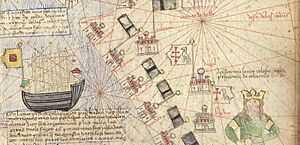
At this time, the Pandya kingdom was in a war between two brothers, Vira and Sundara. The Hoysala king Ballala had taken advantage of this and invaded the Pandyan territory. When Ballala heard about Kafur's march, he quickly returned to his capital, Dwarasamudra. However, he could not put up a strong fight. He made a deal after a short siege. He agreed to give up his wealth and become a ruler paying tribute to Alauddin.
From Dwarasamudra, Malik Kafur marched to the Pandya kingdom. He raided several towns, reaching as far as Madurai. Both Vira and Sundara fled their capitals. So, Kafur could not make them pay tribute to Alauddin. Still, the Delhi army looted many treasures, elephants, and horses. The Delhi historian Ziauddin Barani described this capture of wealth as the greatest since the Muslim capture of Delhi.
During this campaign, a Mongol general named Abachi planned to join the Pandyas. As a result, Alauddin ordered him to be executed in Delhi. This, along with other complaints against Alauddin, caused anger among Mongols who had settled in India after becoming Muslim. Some Mongol leaders planned to kill Alauddin. But Alauddin's spies found out about the plot. Alauddin then ordered a mass killing of Mongols in his empire. According to Barani, 20,000 or 30,000 Mongols died.
Meanwhile, in Devagiri, after Ramachandra's death, his son tried to break free from Alauddin's rule. Malik Kafur invaded Devagiri again in 1313. He defeated the son and became the governor of Devagiri.
Administrative Changes
Alauddin was the most powerful ruler of his dynasty. Unlike earlier rulers, he made big changes to how the government worked. After facing Mongol invasions and several rebellions, he made reforms. These reforms helped him keep a large army and weaken anyone who might rebel against him. Barani also said Alauddin's tax reforms aimed to control the Hindus by taking away their wealth. Historian Satish Chandra believes Alauddin's reforms were based on his idea that fear and control lead to good government. Most of his actions aimed to centralize power and support a large military.
Some of Alauddin's land reforms were continued by later rulers. They even formed the basis for agricultural changes by Sher Shah Suri and Akbar. However, his other rules, like price control, were canceled by his son Qutbuddin Mubarak Shah a few months after his death.
Revenue Reforms
During Alauddin's time, village leaders, who were traditional Hindu authorities, controlled the countryside and farming. He saw their pride and resistance as a major problem for his rule. He also faced talks of plots against him in his court.
After some early plots and Hindu revolts, he tackled the problem. He introduced reforms to support his army and ensure food for his capital. He took away all land owned by his courtiers and nobles. He also canceled land grants. From then on, the central government controlled all tax collection. This meant "everybody was busy with earning a living so that nobody could even think of rebellion." He also ordered rules "for grinding down the Hindus, and for depriving them of that wealth and property which fosters rebellion." The goal was to make Hindus unable to afford horses, fine clothes, or luxuries.
Alauddin brought a large area of fertile land under direct government control. He removed land grants and local rulers in the Ganga-Yamuna Doab region. He imposed a 50% tax on farm produce in much of northern India. This was the highest tax allowed by Islamic law at the time.
Alauddin also removed the Hindu village chiefs who acted as middlemen. He started collecting taxes directly from farmers. He did not add any extra taxes on farming. He also stopped the payment that middlemen received for collecting taxes. Alauddin's tax demand was based on land area. This meant richer villages with more land paid more taxes. He made rural chiefs pay the same taxes as others. He also banned them from charging illegal taxes on peasants. To prevent rebellions, his government took away the wealth, horses, and weapons of the rural chiefs. By controlling these chiefs, Alauddin presented himself as a protector of the weaker people in rural society. However, while farmers were free from landowners' demands, the high state taxes meant a farmer had "barely enough for carrying on his cultivation and his food requirements."
To make these land and farming changes work, Alauddin set up a strong tax system. His government hired many accountants, collectors, and agents. These officials were paid well. But they faced severe punishment if caught taking bribes. Account books were checked carefully, and even small mistakes were punished. This made both large landowners and small farmers afraid of not paying their taxes.
Alauddin's government made non-Muslims pay the jizya tax. His Muslim subjects had to pay zakat. He also taxed homes (ghari) and grazing animals (chara'i). These taxes were not allowed by Islamic law. In addition, Alauddin demanded four-fifths of war spoils from his soldiers. This was more than the traditional one-fifth share.
Market Reforms
Alauddin set up rules to control prices for many goods. His courtier Amir Khusrau and the writer Hamid Qalandar said Alauddin made these changes for the public good. However, Barani stated that Alauddin wanted to lower prices. This would make low salaries acceptable to his soldiers, helping him keep a large army. Barani also suggested that Hindu traders were making too much profit. He said Alauddin's market reforms were meant to punish them.
To make sure goods were sold at set prices, Alauddin appointed market supervisors and spies. He received separate reports from them. To prevent illegal selling, his government stopped farmers and traders from storing grains. He set up government-run storage places for the government's share of grain. The government also made transport workers move to villages at certain distances along the Yamuna river. This helped quickly move grain to Delhi.
Historians like Khusrau and Barani say that prices did not go up during Alauddin's rule. This was true even when there was little rain. Shopkeepers who broke the price rules or used false weights were severely punished.
Military Reforms
Alauddin kept a very large standing army. Some historians say it included 475,000 horsemen. He was able to have such a big army by paying his soldiers relatively low salaries. He introduced market price controls to make sure these low salaries were acceptable. He did not like giving land to his generals and soldiers. However, he rewarded them generously after successful campaigns, especially those in Deccan.
Alauddin's government kept detailed records of every soldier. He regularly held strict inspections of the army to check horses and weapons. To prevent horses from being presented twice or replaced by poor-quality ones, Alauddin started a system of branding the horses.
Social Reforms
Alauddin increased his control over the nobles. To prevent rebellions, he took away their wealth and power bases. Even lands given for charity were taken. Disloyalty was punished severely. Wives and children of soldiers who rebelled for more war spoils were imprisoned. An effective spy network was set up. It even reached into the private homes of nobles. Marriage alliances between noble families had to be approved by the king.
Last Days and Legacy
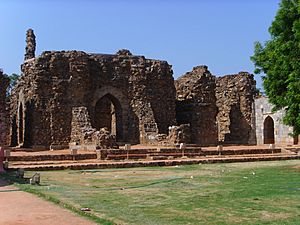
In his final years, Alauddin became ill. He grew very suspicious of his officers. He started giving all power to his family and his trusted slaves. He became very close to his slave-general Malik Kafur. Kafur became the main ruler of the Sultanate after being made viceroy.
Alauddin removed many experienced administrators. He ended the office of wazir (prime minister). He even executed the minister Sharaf Qa'ini. It seems Malik Kafur, who saw these officers as rivals, convinced Alauddin to do this. Kafur had Alauddin's oldest sons, Khizr Khan and Shadi Khan, blinded. He also convinced Alauddin to order the killing of his brother-in-law, Alp Khan. Alp Khan was an important noble who could challenge Malik Kafur's power. It was claimed that the victims had plotted against Alauddin, but this might have been Kafur's way of gaining more power.
Alauddin died on the night of January 4, 1316. Some people believed that Kafur murdered him. Later that night, Kafur brought Alauddin's body from the Siri Palace. He had it buried in Alauddin's tomb, which had been built before his death. The tomb is said to have been near a Jama Mosque.
The next day, Kafur made Alauddin's young son Shihabuddin a puppet ruler. However, Kafur was killed soon after. Alauddin's older son Mubarak Khan then took power.
Alauddin's tomb and a school (madrasa) dedicated to him are still present behind the Qutb complex in Mehrauli, Delhi.
Personal Life
Alauddin had several wives. These included Jalaluddin's daughter, Malika-i-Jahan, and Alp Khan's sister, Mahru. He also married Jhatyapali, the daughter of the Hindu king Ramachandra of Devagiri. This likely happened after his 1296 raid or 1308 conquest of Devagiri. Alauddin had a son with Jhatyapali, Shihabuddin Omar, who later became a Khalji ruler.
Alauddin also married Kamala Devi, a Hindu woman. She was originally the chief queen of Karna, the Vaghela king of Gujarat. She was captured by Khalji forces during an invasion. She was taken to Delhi as part of the war spoils and became part of Alauddin's royal household. She eventually adjusted to her new life. According to the historian Firishta, around 1306-1307, Kamala Devi asked Alauddin to get her daughter Deval Devi from her father, Raja Karan. Alauddin ordered Raja Karan to send Deval Devi immediately. Deval Devi was eventually brought to Delhi and lived in the royal palace with her mother.
Malik Kafur, a talented slave captured during the Gujarat campaign, became very important to Alauddin. He quickly rose in Alauddin's service. This was mainly because he was a skilled military commander and a wise advisor. He eventually became the viceroy of the Sultanate. According to Barani, in the last few years of his life, Alauddin trusted Kafur greatly and gave him control over the government.
Architecture
In 1296, Alauddin built the Hauz-i-Alai, later known as Hauz-i-Khas. This was a large water reservoir covering 70 acres. It had stone walls. Over time, it filled with mud. It was cleaned by Firuz Shah Tughlaq around 1354. The writings of Timur, who invaded Delhi in 1398, mention that this reservoir provided water for the city all year.
In the early 14th century, Alauddin built the Siri Fort. The fort walls were mostly made of rubble and mud. Some parts also used cut stone with lime. Alauddin camped in Siri during the 1303 Mongol invasion. After the Mongols left, he built the Qasr-i-Hazar Situn palace at his camp site. The fortified city of Siri existed during Timur's time. His writings say it had seven gates. It was destroyed by Sher Shah Suri in 1545. Only some ruined walls remain today.
-
Courts to the east of Quwwat ul-Islam mosque, in Qutb complex added by Khalji in 1300 CE.
-
Alauddin's Madrasa, Qutb complex, Mehrauli, which also has his tomb to the south.
-
The unfinished Alai Minar
Alauddin ordered the building of the Alai Darwaza. It was finished in 1311. It serves as the southern entrance to the Quwwat-ul-Islam mosque, which was built by Qutb al-Din Aibak. He also started building the Alai Minar. This tower was meant to be twice the size of the Qutb Minar. But the project was stopped, probably when he died.
The construction of the Lal Mahal (Red Palace) sandstone building has also been linked to Alauddin. Its architecture and design are similar to the Alai Darwaza.
In 1311, Alauddin repaired the 100-acre Hauz-i-Shamasi reservoir. This reservoir had been built by Shamsuddin Iltutmish in 1229. Alauddin also built a dome in its center.
Religious Policy
Views on Religion
Like the rulers before him, Alauddin was a Sunni Muslim.
Historian Ziauddin Barani, writing about 50 years after Alauddin's death, said that Alauddin did not favor Muslim religious scholars (ulama). Barani also wrote that Alauddin's "faith in Islam was firm like the faith of the illiterate and the ignorant." He further states that Alauddin once thought about starting a new religion. Alauddin believed that just as the Islamic prophet Muhammad's first four leaders helped spread Islam, he too had four great generals (Ulugh, Nusrat, Zafar, and Alp). With their help, he thought he could establish a new religion. Barani's uncle, Alaul Mulk, convinced him to drop this idea. He explained that a new religion could only come from a message from God, not from human ideas. Alaul Mulk also argued that even great conquerors like Genghis Khan could not change Islam. He warned that people would rebel if Alauddin tried to start a new religion. Barani's claim that Alauddin thought of founding a religion has been repeated by many later historians. However, historian Banarsi Prasad Saksena doubts this claim. He says it is not supported by writers who lived at the same time as Alauddin.
According to Barani, Alauddin was the first sultan to keep religion separate from the government.
Relationship with Hindus
Sometimes, Alauddin used Muslim religious passion against Hindu chiefs. He also treated non-Muslims (zimmis) in a certain way. The Persian historian Wassaf said that Alauddin sent an army against Gujarat as a holy war. He claimed it was not just for conquest. The poem Deval Devi—Khizr Khan by Amir Khusrau states that Gujarat was only fully taken in the second invasion, seven years after the first. This suggests the first was just a raid for loot. At Khambhat, it is said that the people were surprised. Wassaf stated that "The Muhammadan forces began to kill and slaughter on the right and on the left unmercifully, throughout the impure land, for the sake of Islam, and blood flowed in torrents."
Alauddin and his generals destroyed several Hindu temples during their military campaigns. These included temples at Bhilsa (1292), Devagiri (1295), Vijapur (1298–1310), Somnath (1299), Jhain (1301), Chidambaram (1311), and Madurai (1311).
He made agreements with Hindu chiefs who accepted his rule. In a 1305 document, Khusrau mentioned that Alauddin treated obedient Hindu landlords (zamindars) kindly. He gave them more favors than they expected. Khusrau wrote that by this time, all rebellious Hindus had died in battle. The other Hindus had bowed to Alauddin. Describing a court meeting in October 1312, Khusrau wrote that the ground was colored saffron from the tilaks of Hindu chiefs bowing before Alauddin. This policy of working with Hindus was criticized by a small group of strict Muslims, as seen in Barani's writings.
Alauddin rarely listened to the advice of orthodox religious scholars. When he asked about the status of Hindus under an Islamic state, the qazi (judge) Mughis replied that Hindus "should pay the taxes with meekness and humility." He said they should show extreme submission. He added that God commands their complete degradation. This is because Hindus are seen as enemies of the true prophet.
Alauddin believed "that the Hindu will never be submissive and obedient to the Musalman unless he is reduced to abject poverty." He took steps to make them poor. He felt this was fair because he knew that chiefs and village headmen lived luxurious lives but never paid taxes. His many conquests made him seem like a persecutor at home and abroad. Barani, summarizing his achievements, noted that Hindus were very submissive during the last ten years of his rule. He stated that such submission "has neither been seen before nor will be witnessed hereafter."
Under the Mamluk dynasty, it was hard for Indian Muslims and impossible for Hindus to join the higher government. This seemed to change under the Khaljis. Khusrau states that Alauddin sent a 30,000-strong army under a Hindu officer, Malik Naik, to fight the Mongols. During Ikat Khan's rebellion, Hindu soldiers saved the Sultan's life. Because many non-Muslims were in the imperial army, Alaul Mulk advised Alauddin not to leave Delhi to fight the Mongol Qutlugh Khwaja.
Relationships with Jains
According to Jain records, Alauddin had discussions with Jain wise men. He once specifically called Acharya Mahasena to Delhi. There were no learned Digambara Jain teachers in North India at this time. Mahasena was asked by Jains to defend their faith. Alauddin was impressed by his deep knowledge and simple lifestyle. A Digambara Jain named Purancandra was very close to him. The Sultan also kept in touch with Shwetambara wise men. The Jain poet Acharya Ramachandra Suri was also honored by him.
The Kharataragaccha Pattavali, finished in 1336–1337, describes harsh actions against Jains during his rule. This included the destruction of a religious fair in 1313 when Jabalipura (Jalor) was captured. Conditions seem to have improved a year later. Banarasidas in Ardhakathanaka mentions that Jain Shrimala merchants were spread across North India. In 1314, the sons of a Shrimala and others, along with their relatives and many pilgrims, were able to visit a temple at Phaludi. This happened even though Ajmer and nearby areas were under siege by Muslim forces.
Alp Khan, who was moved to Gujarat in 1310, is praised by Jain sources. He allowed the rebuilding of their temples. Kakkasuri in Nabhi-nandana-jinoddhara-prabandha mentions Alp Khan giving an official order (farman) to the Jain merchant Samara Shah. This order allowed him to repair a damaged Shatrunjaya temple. Alp Khan is also said to have given large donations for repairing Jain temples.
Coins
Khalji minted coins using the title Sikander Sani. Sikander is an Old Persian word for 'Alexander', a title made famous by Alexander the Great. Sani is Arabic for 'Second'. The coin's inscription, Sikander-e -Sani, means 'The Second Alexander'. This recognized his military success.
He gathered a lot of wealth in his treasury from campaigns in Deccan and South India. He issued many coins. His coins did not mention the Khalifa. Instead, they used the self-praising title Sikander-us-sani Yamin-ul-Khilafat. He stopped adding Al-Musta'sim's name. Instead, he added Yamin-ul-Khilafat Nāsir Amīri 'l-Mu'minīn (The right hand of the Caliphate, the helper of the Commander of the Faithful).
See also
 In Spanish: Alaudín para niños
In Spanish: Alaudín para niños


